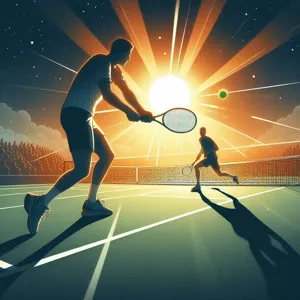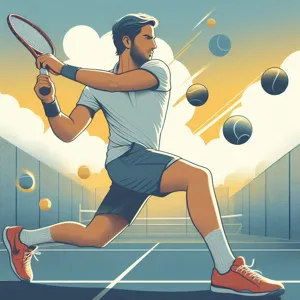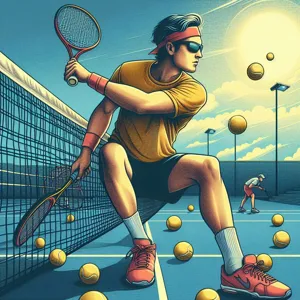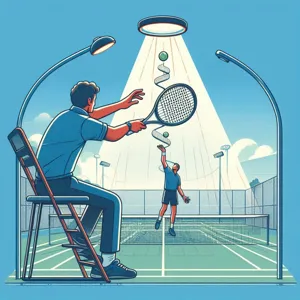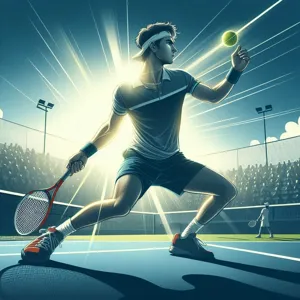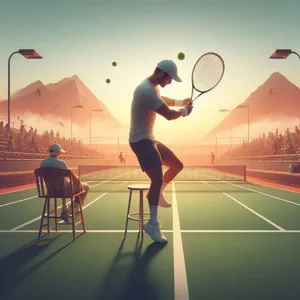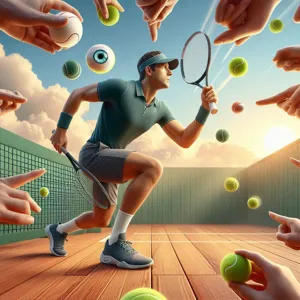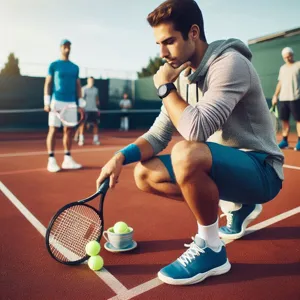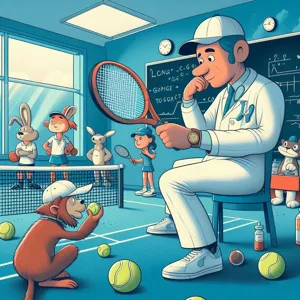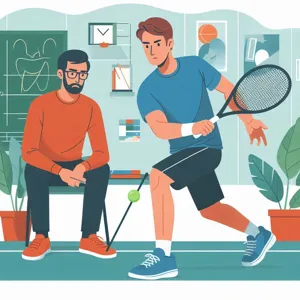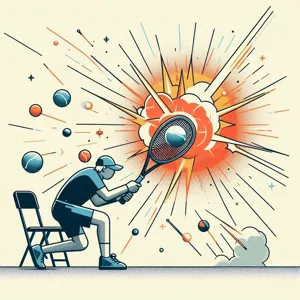Mastering the backhand is essential for any tennis player looking to elevate their game and dominate the court.
This often-underestimated shot can be a powerful weapon in your arsenal when executed properly. Whether you’re a beginner aiming to improve your fundamentals or an experienced player seeking to refine your technique, understanding the intricacies of the backhand can make all the difference. In this blog post, we’ll delve into the essential techniques that will help you develop a strong, reliable backhand. From grip variations and footwork to timing and follow-through, we’ll cover everything you need to know to unleash the true potential of this crucial stroke. Get ready to impress your opponents with your newfound skills and transform your gameplay as we explore the art of the backhand!
1. Introduction to the Backhand Shot

The backhand shot is one of the most crucial strokes in a tennis player’s arsenal, capable of turning the tide of a match when executed with precision and power. Unlike the forehand, which many players instinctively favor due to its more natural motion, the backhand often requires dedicated practice and technique to master. This shot can be performed with either one hand or two, each offering distinct advantages depending on the player’s style, strength, and comfort level.
In essence, the backhand serves as a counterbalance to the forehand, allowing players to strike the ball from both sides of the court effectively. Whether it’s a topspin backhand that bounces high, a slicing backhand that skids low, or a powerful flat backhand that rockets off the court, this shot can be incredibly versatile. It not only adds depth to a player’s game but also opens up various tactical options, making it easier to exploit an opponent’s weaknesses.
Moreover, the backhand is often the shot that players rely on during long rallies, as it allows for remarkable control and placement. A well-executed backhand can create angles that disrupt an opponent’s rhythm and force them into defensive positions. As we delve into the essential techniques for mastering the backhand, we’ll explore grip variations, footwork strategies, and drills that will enhance your ability to deliver a powerful and consistent backhand shot, ultimately elevating your overall performance on the court. Whether you’re a beginner seeking to build a solid foundation or an experienced player looking to refine your technique, understanding the intricacies of the backhand is essential for any aspiring tennis champion.
2. Understanding the Mechanics of a Backhand
To master the backhand, it’s crucial to understand the mechanics that underpin this essential shot. Unlike the forehand, which often feels more natural to many players, the backhand requires a blend of precision, strength, and technique.
The key to a powerful backhand begins with your grip. Most players opt for either the Eastern or the Continental grip. The Eastern grip helps in generating more topspin, while the Continental is versatile enough for both slice and topspin shots. Whichever grip you choose, ensure that it feels comfortable and allows for quick adjustments during gameplay.
Next, focus on your stance. Position your feet shoulder-width apart and pivot your body sideways to the net. This rotation not only sets you up for the shot but also enables you to engage your core, providing a solid foundation for power. As the ball approaches, step into the shot with your non-dominant foot, allowing your body to shift weight from the back foot to the front foot. This transfer of weight is vital for generating the momentum needed for a strong backhand.
The swing itself is a dance of fluid motion. Begin by bringing your racket back in a smooth, controlled motion. As you prepare to make contact with the ball, your non-dominant hand should point toward the ball, guiding your racket into position. Aim to strike the ball at waist height, utilizing your legs and core to drive through the shot. The follow-through is equally important; extend your racket fully after contact, allowing your arm to naturally finish across your body, which not only adds power but also helps with accuracy.
Lastly, practice is key. Spend time developing muscle memory through drills, focusing on the mechanics of your backhand until it becomes second nature. By mastering these foundational elements, you’ll not only increase your shot’s power but also enhance your overall confidence on the court, making your backhand a formidable weapon in your tennis arsenal.
3. Grip Styles: Choosing the Right Grip for Your Backhand
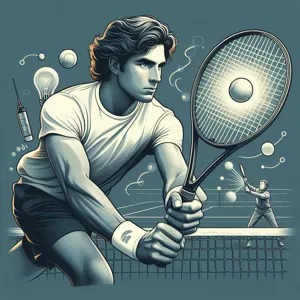
When it comes to mastering the backhand, one of the most crucial decisions you’ll make is selecting the right grip style. Your grip not only influences the power and precision of your shot but also affects your overall comfort and control on the court. There are three primary grip styles to consider: the Eastern grip, the Continental grip, and the Western grip, each offering its unique advantages and challenges.
**Eastern Grip**: This grip is often recommended for beginners due to its versatility and ease of use. To achieve the Eastern grip, place the base knuckle of your index finger on the third bevel of the racket handle. This grip allows for a natural swing path, enabling you to generate both topspin and slice effectively. Players who favor the Eastern grip often appreciate its balance, as it facilitates a fluid stroke while still providing adequate power.
**Continental Grip**: Known as the “serve and volley” grip, the Continental grip is popular among players who frequently approach the net. With this grip, the base knuckle of your index finger rests on the second bevel. The beauty of the Continental grip lies in its adaptability; it allows you to execute a variety of shots, from volleys to overheads, with finesse. However, mastering the backhand with this grip requires practice, as it can be challenging to generate topspin compared to the Eastern and Western grips.
**Western Grip**: For those looking to add significant topspin to their backhand, the Western grip is an excellent choice. To adopt this grip, place the base knuckle of your index finger on the fourth bevel of the racket handle. This grip encourages a low-to-high swing path, creating a high arc on the ball that can be particularly effective during baseline rallies. While the Western grip can produce powerful shots, it may require more time to master, particularly when it comes to timing and swing mechanics.
Ultimately, the choice of grip style should align with your playing style, skill level, and comfort. Experimenting with each grip will help you find the one that feels most natural in your hand. Once you’ve settled on a grip, focus on refining your technique through consistent practice. Remember, a confident backhand begins with a solid grip!
4. Stance and Positioning: Setting Up for Success
When it comes to mastering the backhand in tennis, your stance and positioning are fundamental to executing a powerful shot. The right setup can make all the difference in the world, transforming a mediocre backhand into a force to be reckoned with.
Begin by positioning your feet shoulder-width apart, establishing a solid base that allows for balance and mobility. Your knees should be slightly bent, ready to spring into action as the ball approaches. The key is to maintain a low center of gravity, which will enhance your stability and give you the necessary leverage to generate power.
As you anticipate the ball, pivot your body sideways to the net, turning your non-dominant shoulder toward the court. This stance not only helps you align your body with the trajectory of the ball but also prepares you to engage your core muscles, which are essential for transferring weight into the shot. Depending on whether you prefer a one-handed or two-handed backhand, adjust your grip accordingly. For a one-hander, your dominant hand should be placed on the racket’s handle, while your non-dominant hand provides support at the throat. If you’re opting for a two-handed backhand, both hands should work in tandem, providing stability and control.
Positioning is equally crucial. As you track the ball, take a quick step to the side, ensuring you’re in the optimal spot to make contact. Ideally, aim to strike the ball at waist height, allowing for a more fluid follow-through. Remember, the goal is to meet the ball with your racket at the right moment and angle, which is why footwork is vital. Quick, precise movements will help you get into the perfect position, setting the stage for a successful backhand.
Ultimately, the right stance and positioning create the foundation for a powerful backhand. As you practice these techniques, envision yourself gliding into position with confidence, knowing that every successful shot begins with a solid setup. So, lace up your shoes, hit the court, and focus on perfecting this essential aspect of your game—your powerful backhand is just a stance away!
5. The Role of Footwork in Executing a Backhand
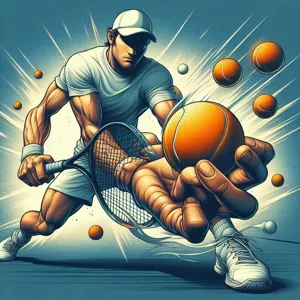
Footwork is the unsung hero of a powerful backhand shot in tennis, serving as the foundation upon which all other techniques are built. As any seasoned player knows, the backhand is not just about swinging the racket; it’s about positioning your body correctly to generate maximum force and accuracy. To execute a flawless backhand, your feet need to be quick and nimble, allowing you to move smoothly into position for the shot.
The first step in effective footwork is establishing a strong base. As the ball approaches, you should be light on your feet, ready to pivot and shift your weight. A common mistake among novice players is to remain flat-footed, which can lead to poor timing and inconsistent strikes. Instead, practice maintaining a slight bend in your knees and staying on the balls of your feet. This athletic stance not only enhances your balance but also prepares you for explosive lateral movements.
Once you’ve set your stance, it’s crucial to practice the proper footwork patterns. For a two-handed backhand, you’ll typically take small, quick steps to close the distance between you and the ball, allowing your racket to come back in a smooth, controlled motion. For a one-handed backhand, the focus shifts slightly; you’ll want to step into the shot with your opposite foot to ensure you’re generating enough power and follow-through. The art of footwork lies in its rhythm – your steps should be fluid and deliberate, coordinating perfectly with your swing.
Don’t underestimate the importance of recovery as well. After hitting your backhand, be prepared to move quickly into your next shot. Practicing your footwork drills not only enhances your agility but also builds the muscle memory needed to respond instinctively during a match. Remember, the better your footwork, the more opportunities you create for yourself, allowing you to hit a clean, powerful backhand that can turn the tide of a game. By honing this essential aspect of your game, you’ll find your backhand becomes a formidable weapon on the court, instilling confidence in your overall play.
6. One-Handed vs. Two-Handed Backhand: Pros and Cons
When it comes to mastering the backhand in tennis, players often face a pivotal choice: the one-handed backhand or the two-handed backhand. Each technique comes with its own unique set of advantages and disadvantages, and understanding these can help you determine which style best suits your game.
### One-Handed Backhand
The one-handed backhand is a classic stroke that offers an elegant and fluid motion. One of its significant advantages is the range of motion it provides, allowing players to generate impressive topspin and slice when executed correctly. This technique can be particularly effective for handling low balls, enabling players to carve out sharp angles and create a variety of shots that keep opponents guessing. Additionally, the one-handed backhand grants players access to a more expansive court coverage, as it allows for quicker transitions to volleys and overheads.
However, mastering the one-handed backhand requires a considerable amount of practice and strength, particularly in the wrist and forearm. It can be challenging to maintain consistency, especially under pressure, and players may find it more difficult to handle high balls or fast-paced shots. This technique also demands a more precise timing, making it less forgiving for beginners or those still developing their skills.
### Two-Handed Backhand
In contrast, the two-handed backhand offers a solid and stable foundation for players, providing greater control and power right from the start. The use of both hands allows for enhanced stability during the stroke, which can lead to improved accuracy and consistency. This technique is particularly advantageous when dealing with high balls, as the additional hand provides extra leverage and control over the shot. Many players find the two-handed backhand easier to learn, making it a popular choice among beginners and intermediate players alike.
On the downside, the two-handed backhand can sometimes limit the range of motion, which may hinder the ability to generate extreme angles or spin. Players might also find it less effective when attempting to transition to net play, as the grip can feel cumbersome when switching to volleys. Additionally, the reliance on both hands can lead to challenges when reaching for wide shots, requiring quick footwork and positioning to successfully execute the stroke.
### Conclusion
Ultimately, the decision between a one-handed and two-handed backhand boils down to personal preference, playing style, and physical attributes. Both techniques have their merits and can be powerful weapons on the court when mastered. Experimenting with both strokes during practice can provide valuable insights into which approach feels more natural and effective for you, ensuring that your backhand becomes a formidable part of your game.
7. How to Generate Power in Your Backhand

Generating power in your backhand is a skill that can significantly elevate your tennis game, turning what was once a mere defensive shot into a potent weapon. To unleash that power, focus on a combination of technique, body mechanics, and mental approach.
Start by positioning yourself correctly. As the ball approaches, ensure you are in an athletic stance, which means your feet should be shoulder-width apart, knees slightly bent, and weight balanced on the balls of your feet. This foundation allows for better movement and stability as you prepare to strike the ball.
As you prepare for the shot, use your non-dominant hand to guide the racket back, creating a coiling effect in your upper body. This coiling is crucial; it stores energy much like a spring. As you begin your forward swing, initiate the movement from your hips and shoulders rather than just your arms. This rotational movement will help generate momentum and transfer energy from your lower body into your shot.
Focus on your grip as well. A semi-western or eastern grip can provide the optimal balance between control and power. Make sure your grip is firm but not overly tight; too much tension can hinder your swing and reduce power.
As you make contact with the ball, aim to hit it at waist height, ideally with a slight forward tilt of the racket face. This angle will help you drive through the ball, creating a more formidable force. Follow through with your swing, allowing your racket to extend fully and finish high above your shoulder. This not only enhances power but also ensures better accuracy and spin.
Finally, practice your footwork. being able to move quickly into position allows you to set up for your shot effectively, ensuring you can make the most out of each swing. Incorporate drills that focus on backhand footwork, and don’t shy away from hitting against a wall or with a partner to refine your timing and technique.
By mastering these essential elements, you’ll find that generating power in your backhand becomes second nature, making it a formidable part of your overall game. With consistent practice and focus, you’ll transform your backhand into a dynamic shot that keeps your opponents on their toes.
8. Key Drills for Improving Backhand Technique
Improving your backhand technique requires dedication and practice, but incorporating specific drills into your training regimen can make all the difference. Here are some key drills designed to enhance your backhand stroke and build the muscle memory necessary for executing powerful and accurate shots during matches.
**1. One-Handed Backhand Shadow Swings:** If you’re focusing on a one-handed backhand, begin by practicing shadow swings without a ball. Stand in front of a mirror or on the court, and visualize hitting the ball. Focus on your grip, stance, and follow-through. This drill helps you fine-tune your mechanics and build confidence without the pressure of hitting a ball.
**2. Backhand Wall Drills:** Find a solid wall for this drill. Stand a few feet away and hit the ball against the wall, focusing on generating consistent backhands. Start with a medium pace and gradually increase the speed as you become more comfortable. This drill improves your timing, hand-eye coordination, and power. Pay attention to your body positioning and make adjustments as needed.
**3. Cross-Court Backhand Rally:** Partner up for this drill. Stand on opposite sides of the court and rally backhands cross-court. This helps you develop accuracy and consistency while reinforcing your footwork. As you improve, challenge each other by increasing the pace and depth of your shots, which simulates match conditions and helps you adapt to different playing styles.
**4. Target Practice:** Set up targets on the court using cones or hula hoops. During practice, aim to hit your backhands into these targets. This drill hones your accuracy and allows you to experiment with different spins and trajectories. It also encourages you to focus on your shot placement, a crucial element in outmaneuvering your opponent.
**5. Backhand with Spin:** To master the art of spin, practice hitting your backhand with topspin and slice. Use a ball machine or partner to feed you balls, focusing on generating spin with your racket. For topspin, brush up on the ball, and for slice, angle your racket face slightly downward. This drill adds variety to your game and makes your backhand more unpredictable.
Incorporating these drills into your training can significantly elevate your backhand technique. Consistent practice will not only enhance your skill set but also increase your confidence on the court. Remember, mastering the backhand is a journey—embrace the process, stay patient, and watch as your hard work transforms your game.
9. Common Mistakes to Avoid in Your Backhand
When it comes to perfecting your backhand, awareness of common pitfalls can be just as crucial as mastering the right techniques. Many players, both novice and experienced, often find themselves falling into familiar traps that hinder their performance and limit their potential on the court. Here are some of the most frequent mistakes to avoid to ensure you’re hitting a powerful backhand every time.
**1. Poor Grip Choice:** One of the first mistakes players make is using the wrong grip. Many beginners default to an eastern grip, which can limit their ability to generate topspin. Instead, consider using a semi-western grip for more control and spin, or even an eastern grip for more flat shots. Experiment and find what feels comfortable and effective for your style of play.
**2. Neglecting Footwork:** The importance of footwork cannot be overstated. Many players fail to position themselves correctly before executing their backhand, resulting in awkward swings and reduced power. Proper footwork allows you to get into the optimal stance, giving you better balance and control. Always practice your footwork drills to ensure you can move fluidly and set up properly for every shot.
**3. Overreliance on Upper Body Strength:** While generating power in your backhand does involve your upper body, overemphasizing arm strength can lead to tension and inconsistency. Instead, focus on using your whole body—core, legs, and shoulders—to create a fluid, integrated motion. This not only increases power but also enhances your shot’s accuracy.
**4. Lack of Follow-Through:** A common mistake is failing to complete the follow-through after making contact with the ball. A short follow-through can lead to a lack of control and power. Make sure you extend your arm fully and finish high; this will help you maintain directional control and impart spin on the ball.
**5. Inconsistent Timing:** Timing is crucial in tennis, and many players struggle with hitting the ball at the right moment. Practice hitting against a wall or with a partner to develop a better sense of timing. Focus on making contact with the ball at the peak of its bounce to maximize your control and power.
By being mindful of these common mistakes and actively working to correct them, you can transform your backhand into a formidable weapon on the court. Remember, every great player has faced challenges along the way, so keep practicing and refining your technique, and you’ll see significant improvements in your game.
10. Analyzing Professional Players’ Backhands
Analyzing professional players’ backhands can provide invaluable insights into mastering this crucial shot. By observing the techniques and styles of top players, you can uncover the nuances that separate a good backhand from a great one.
Take, for instance, the fluidity of Rafael Nadal’s two-handed backhand. His ability to generate topspin not only gives him control but also forces opponents to adjust their positioning. Notice how he uses his legs and core to transfer power, emphasizing the importance of a strong foundation. As you watch him play, pay attention to his grip and how it shifts to handle different spins and speeds.
On the other hand, consider the elegance of Roger Federer’s one-handed backhand. His technique is a masterclass in timing and precision. Observe how he maintains a relaxed grip until the moment of contact, allowing for both power and finesse. Federer’s ability to slice the ball deep into the court demonstrates the versatility of the one-handed backhand, serving as both an offensive weapon and a defensive tool.
As you analyze these players, focus on their footwork, the angle of their racquet during contact, and their follow-through. Each of these elements plays a crucial role in the effectiveness of their backhands. By incorporating lessons learned from these professionals into your practice, you can refine your own technique, adapt their strategies to your style, and ultimately elevate your game. Remember, mastering the backhand isn’t just about mimicking what you see; it’s about understanding the principles behind their success and finding ways to apply them to your own play.
11. Incorporating Spin: Topspin vs. Slice Backhands
In the world of tennis, mastering the backhand is not just about power; it’s also about finesse and control. One of the most effective ways to elevate your backhand is by incorporating spin, specifically topspin and slice. Each type of spin serves a distinct purpose and can drastically alter the dynamics of your shot.
**Topspin Backhands** are typically executed with a low-to-high swing path, allowing the racket to brush up against the ball. This technique generates a forward rotation that causes the ball to dip quickly after clearing the net, making it a formidable weapon against opponents. The topspin backhand not only ensures a higher margin for error—since the ball can clear the net by a significant height—but also enables you to dictate the pace and depth of the rally. When executed properly, a topspin backhand can push your opponent back, setting you up for a commanding follow-up shot.
On the other hand, the **Slice Backhand** involves a more horizontal racket face and a cutting motion that imparts backspin on the ball. This technique is particularly useful when you want to change the pace of a rally or keep your opponent off balance. A well-timed slice backhand skims low over the net, making it challenging for your opponent to attack. It can also be an effective defensive shot, allowing you to buy time and reposition yourself on the court. Additionally, the slice can be an excellent weapon on approach shots, setting you up to follow the ball to the net.
Incorporating both topspin and slice into your backhand arsenal not only enhances your versatility on the court but also keeps your opponents guessing. Practicing these techniques will give you the confidence to adapt to various match situations, ensuring you can handle any challenge your opponent throws your way. Remember, the key to mastering these spins lies in your grip, stance, and swing mechanics—so take the time to refine these elements, and watch your backhand transform into a powerful, strategic tool in your game.
12. The Importance of Timing and Rhythm
When it comes to mastering the backhand, understanding the importance of timing and rhythm can make all the difference between a good shot and a great one. Timing is the delicate art of making contact with the ball at the precise moment, where every millisecond counts. The key is to anticipate the ball’s trajectory, adjusting your position accordingly to ensure you meet it at the optimal point—ideally at waist height. This requires not just keen eye-hand coordination but also an innate sense of the game, allowing you to read your opponent’s shots and react accordingly.
Rhythm, on the other hand, is about creating a fluid and consistent motion that makes your backhand not just effective, but also aesthetically pleasing. It’s the smooth transition from preparation to execution, where your body flows seamlessly from one phase to the next. To develop this rhythm, practice is essential. Drills that emphasize repetitive backhand strokes help you internalize the timing and build muscle memory, allowing your body to respond instinctively during a match.
Visualize your backhand as a dance: each step, every swing, and follow-through should feel connected. As you swing, focus on maintaining a steady tempo, allowing your body to move in harmony with your arm. A rush in your swing can lead to mishits; conversely, a sluggish approach may result in lost opportunities. Striking that balance will empower you to unleash a powerful backhand that not only catches your opponent off guard but also boosts your confidence on the court.
Incorporating drills that emphasize timing, such as hitting against a wall or practicing with a partner, can significantly enhance your backhand strokes. Use these opportunities to refine your rhythm, ensuring that your movements feel synchronized and natural. Remember, it’s not just about hitting the ball—it’s about doing so with finesse and control. As you develop your timing and rhythm, your backhand will transform from a mere shot into a formidable weapon in your tennis arsenal.
13. Strategies for Using the Backhand in Matches
When it comes to mastering the backhand in tennis, having a strong technique is only part of the equation. To truly harness the power of your backhand during matches, you need to develop effective strategies that can turn your shot into a formidable weapon against your opponent. Here are some key strategies to consider:
**1. Positioning and Footwork:** Your footwork plays a crucial role in executing a successful backhand. Always strive to position yourself optimally, allowing your body to align with the incoming ball. Use small, quick steps to get into the right stance. The more balanced you are, the more powerful and controlled your shot will be.
**2. Use of Angles:** A well-placed backhand can force your opponent out of position. By utilizing angles, you can create opportunities to open up the court. Instead of hitting straight down the line all the time, try slicing or angling your backhand to stretch your opponent and create space for your next shot.
**3. Incorporating Spin:** Adding spin to your backhand can make it more unpredictable and challenging to return. A topspin backhand allows the ball to clear the net with safety while still dipping sharply into your opponent’s court. Conversely, a slice backhand can disrupt your opponent’s rhythm, especially when they are expecting a flat shot.
**4. Targeting Weaknesses:** Pay attention to your opponent’s weaknesses throughout the match. If they struggle with high balls, aim for their backhand and hit with depth and height. If they have a weaker backhand, exploit that by directing your shots toward that side, forcing errors and creating scoring opportunities.
**5. Setting Up for the Next Shot:** A powerful backhand isn’t just about winning the point with a single shot. Consider how it sets you up for the next play. Aim to hit your backhand deep into the court, allowing you to take control of the rally and prepare for an aggressive follow-up shot.
**6. Practice Under Pressure:** The ability to execute a strong backhand in match situations comes from consistent practice. Incorporate drills that simulate match conditions, focusing on your backhand under pressure. This will not only build muscle memory but also enhance your confidence in using the shot when it counts the most.
By integrating these strategies into your gameplay, your backhand can become a key element of your tennis arsenal, allowing you to dictate points and keep your opponents on their toes. Remember, mastering the backhand is not just about technique; it’s about strategic thinking and adaptability on the court.
14. Mental Aspects: Building Confidence in Your Backhand
Mastering the backhand isn’t just about physical technique; it’s also a mental game. Building confidence in your backhand can significantly impact your performance on the court. The psychological aspects of tennis often go unnoticed, yet they play a crucial role in how players approach each shot.
First and foremost, visualization is a powerful tool. Before stepping onto the court, take a moment to visualize yourself executing the perfect backhand. Imagine the feel of the racket in your hands, the sound of the ball connecting, and the satisfaction of watching it soar over the net with precision. This mental rehearsal prepares your brain for success, creating a sense of familiarity that can ease anxiety during actual play.
Another vital element is positive self-talk. Replace any negative thoughts about your backhand with affirmations that reinforce your abilities. Phrases like “I am a strong hitter” or “My backhand is reliable” can shift your mindset from doubt to confidence. Remember, tennis is as much a mental sport as it is physical; the way you speak to yourself can dictate your level of performance.
Moreover, practice under pressure is essential. Simulate match situations during your training sessions where you must execute your backhand in various scenarios—whether it’s a tight score or a challenging opponent. The more you practice your backhand while under pressure, the more confident you will become in your ability to deliver when it truly matters.
Finally, embrace the journey of improvement. Every player has moments of struggle, but understanding that mastery takes time can alleviate the pressure you may place on yourself. Celebrate small victories along the way; each successful backhand shot reinforces your confidence.
By focusing on these mental aspects, you can cultivate a strong belief in your backhand that will not only enhance your performance but also elevate your overall enjoyment of the game. Remember, confidence is not just about believing you can hit a great backhand—it’s about knowing you will.
15. Conclusion: Practicing for Mastery and Consistency
In conclusion, mastering the backhand is not merely about hitting the ball; it’s about developing a consistent and powerful shot that can elevate your entire game. As we’ve explored, the key to achieving this lies in focused practice and a commitment to refining your technique.
Whether you prefer the one-handed or two-handed backhand, repetition is essential. Regularly dedicating time to drills that emphasize footwork, swing mechanics, and follow-through will gradually build muscle memory, allowing you to execute your backhand with precision and confidence during matches. Incorporate a variety of practices into your routine, such as shadow swings, hitting against a wall, or working with a partner. This diversity not only keeps training engaging but also ensures that you are prepared for different scenarios on the court.
Remember, consistency is king. Aim for a balance between power and placement; a well-placed backhand can often be more effective than a powerful one that lacks accuracy. Pay attention to your grip, stance, and timing, making adjustments as needed based on your observations and feedback from experienced players or coaches.
Finally, stay patient and persistent. Mastery takes time, and every player’s journey is unique. Celebrate small victories along the way and learn from any setbacks. With dedication and the right mindset, your backhand can become a formidable weapon that not only enhances your skill set but also transforms your overall performance on the court. So grab your racket, hit the practice courts, and watch as your hard work pays off in every match you play.
In conclusion, mastering the backhand is a game-changer for any tennis player looking to elevate their performance on the court. By incorporating the essential techniques we’ve discussed—such as proper grip, footwork, and follow-through—you’ll not only enhance your backhand shot but also boost your overall confidence and effectiveness during matches. Remember, practice makes perfect, so make it a point to dedicate time to refining this crucial skill. Embrace the journey of improvement, and soon enough, you’ll find yourself delivering powerful backhands that can turn the tide of any game. Thank you for joining us on this exploration of backhand mastery, and we can’t wait to see you shine in your next match!



